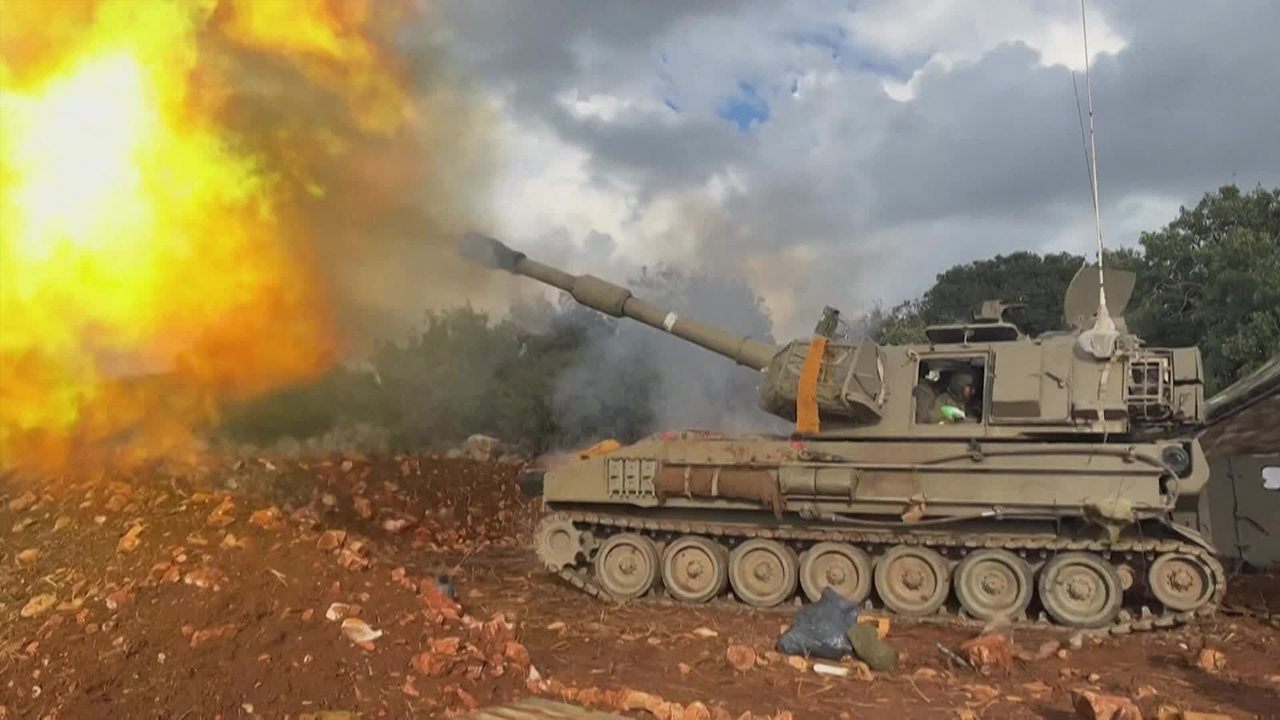Israel expands front line, receiving $17.9 billion military support from U.S.
입력 2024.10.08 (05:31)
읽어주기 기능은 크롬기반의
브라우저에서만 사용하실 수 있습니다.
[Anchor]
In this way, Israel has expanded its frontlines against Hamas, Hezbollah, the Houthis, and Iran, investing enormous warfare expenses.
There are also analyses suggesting that the United States has provided over 15 billion dollars in military support during this process.
Next, Park Seok-ho reports.
[Report]
The war in the Gaza Strip originated from Hamas's surprise attack last October.
In response to attacks from nearby pro-Iran armed groups allied with Hamas, the frontlines continued to expand.
Targets of the Israeli military included not only the Gaza Strip but also southern Lebanon, where Hezbollah is based, the Iranian consulate in Syria, near Iran's nuclear facilities in Isfahan, and the Houthis' stronghold in the port city of Hodeidah, Yemen.
[Benjamin Netanyahu/Israeli Prime Minister: "Israel has the duty and the right to protect itself and respond to attacks, and it will do so."]
In the past year, the death toll has exceeded 43,000 in Palestine and Lebanon.
During the Hamas surprise attack, 1,200 people were killed, and 250 were kidnapped in Israel.
Since then, over 340 soldiers have died in ground combat.
During the war, Hamas and Hezbollah fired more than 25,000 missiles and rockets at Israel.
The multi-layered missile defense system, including the Iron Dome, cost up to $1.54 billion a day to intercept these attacks.
[John Gambrell/AP News Reporter: "The missiles for the Iron Dome typically cost anywhere around $50,000 a piece, for that Arrow system it's upwards of $2 million a missile. That's why the Israeli military is very careful about when they use them."]
If the war continues until next year, Israel's warfare expenses are expected to reach $66 billion.
Although there have been conflicts over ceasefire negotiations, the largest supporter remains the United States.
According to a survey by Brown University, the U.S. has spent at least $17.9 billion, sending precision-guided bombs to the Israeli military and conducting operations against the Houthis in the Red Sea.
This is KBS News, Park Seok-ho.
In this way, Israel has expanded its frontlines against Hamas, Hezbollah, the Houthis, and Iran, investing enormous warfare expenses.
There are also analyses suggesting that the United States has provided over 15 billion dollars in military support during this process.
Next, Park Seok-ho reports.
[Report]
The war in the Gaza Strip originated from Hamas's surprise attack last October.
In response to attacks from nearby pro-Iran armed groups allied with Hamas, the frontlines continued to expand.
Targets of the Israeli military included not only the Gaza Strip but also southern Lebanon, where Hezbollah is based, the Iranian consulate in Syria, near Iran's nuclear facilities in Isfahan, and the Houthis' stronghold in the port city of Hodeidah, Yemen.
[Benjamin Netanyahu/Israeli Prime Minister: "Israel has the duty and the right to protect itself and respond to attacks, and it will do so."]
In the past year, the death toll has exceeded 43,000 in Palestine and Lebanon.
During the Hamas surprise attack, 1,200 people were killed, and 250 were kidnapped in Israel.
Since then, over 340 soldiers have died in ground combat.
During the war, Hamas and Hezbollah fired more than 25,000 missiles and rockets at Israel.
The multi-layered missile defense system, including the Iron Dome, cost up to $1.54 billion a day to intercept these attacks.
[John Gambrell/AP News Reporter: "The missiles for the Iron Dome typically cost anywhere around $50,000 a piece, for that Arrow system it's upwards of $2 million a missile. That's why the Israeli military is very careful about when they use them."]
If the war continues until next year, Israel's warfare expenses are expected to reach $66 billion.
Although there have been conflicts over ceasefire negotiations, the largest supporter remains the United States.
According to a survey by Brown University, the U.S. has spent at least $17.9 billion, sending precision-guided bombs to the Israeli military and conducting operations against the Houthis in the Red Sea.
This is KBS News, Park Seok-ho.
■ 제보하기
▷ 카카오톡 : 'KBS제보' 검색, 채널 추가
▷ 전화 : 02-781-1234, 4444
▷ 이메일 : kbs1234@kbs.co.kr
▷ 유튜브, 네이버, 카카오에서도 KBS뉴스를 구독해주세요!
- Israel expands front line, receiving $17.9 billion military support from U.S.
-
- 입력 2024-10-08 05:31:01

[Anchor]
In this way, Israel has expanded its frontlines against Hamas, Hezbollah, the Houthis, and Iran, investing enormous warfare expenses.
There are also analyses suggesting that the United States has provided over 15 billion dollars in military support during this process.
Next, Park Seok-ho reports.
[Report]
The war in the Gaza Strip originated from Hamas's surprise attack last October.
In response to attacks from nearby pro-Iran armed groups allied with Hamas, the frontlines continued to expand.
Targets of the Israeli military included not only the Gaza Strip but also southern Lebanon, where Hezbollah is based, the Iranian consulate in Syria, near Iran's nuclear facilities in Isfahan, and the Houthis' stronghold in the port city of Hodeidah, Yemen.
[Benjamin Netanyahu/Israeli Prime Minister: "Israel has the duty and the right to protect itself and respond to attacks, and it will do so."]
In the past year, the death toll has exceeded 43,000 in Palestine and Lebanon.
During the Hamas surprise attack, 1,200 people were killed, and 250 were kidnapped in Israel.
Since then, over 340 soldiers have died in ground combat.
During the war, Hamas and Hezbollah fired more than 25,000 missiles and rockets at Israel.
The multi-layered missile defense system, including the Iron Dome, cost up to $1.54 billion a day to intercept these attacks.
[John Gambrell/AP News Reporter: "The missiles for the Iron Dome typically cost anywhere around $50,000 a piece, for that Arrow system it's upwards of $2 million a missile. That's why the Israeli military is very careful about when they use them."]
If the war continues until next year, Israel's warfare expenses are expected to reach $66 billion.
Although there have been conflicts over ceasefire negotiations, the largest supporter remains the United States.
According to a survey by Brown University, the U.S. has spent at least $17.9 billion, sending precision-guided bombs to the Israeli military and conducting operations against the Houthis in the Red Sea.
This is KBS News, Park Seok-ho.
In this way, Israel has expanded its frontlines against Hamas, Hezbollah, the Houthis, and Iran, investing enormous warfare expenses.
There are also analyses suggesting that the United States has provided over 15 billion dollars in military support during this process.
Next, Park Seok-ho reports.
[Report]
The war in the Gaza Strip originated from Hamas's surprise attack last October.
In response to attacks from nearby pro-Iran armed groups allied with Hamas, the frontlines continued to expand.
Targets of the Israeli military included not only the Gaza Strip but also southern Lebanon, where Hezbollah is based, the Iranian consulate in Syria, near Iran's nuclear facilities in Isfahan, and the Houthis' stronghold in the port city of Hodeidah, Yemen.
[Benjamin Netanyahu/Israeli Prime Minister: "Israel has the duty and the right to protect itself and respond to attacks, and it will do so."]
In the past year, the death toll has exceeded 43,000 in Palestine and Lebanon.
During the Hamas surprise attack, 1,200 people were killed, and 250 were kidnapped in Israel.
Since then, over 340 soldiers have died in ground combat.
During the war, Hamas and Hezbollah fired more than 25,000 missiles and rockets at Israel.
The multi-layered missile defense system, including the Iron Dome, cost up to $1.54 billion a day to intercept these attacks.
[John Gambrell/AP News Reporter: "The missiles for the Iron Dome typically cost anywhere around $50,000 a piece, for that Arrow system it's upwards of $2 million a missile. That's why the Israeli military is very careful about when they use them."]
If the war continues until next year, Israel's warfare expenses are expected to reach $66 billion.
Although there have been conflicts over ceasefire negotiations, the largest supporter remains the United States.
According to a survey by Brown University, the U.S. has spent at least $17.9 billion, sending precision-guided bombs to the Israeli military and conducting operations against the Houthis in the Red Sea.
This is KBS News, Park Seok-ho.
이 기사가 좋으셨다면
-
좋아요
0
-
응원해요
0
-
후속 원해요
0











![[속보] 금강서 물놀이하다 실종된 20대 4명 전원 <br>심정지 상태 발견](/attach/image/2025/03/23/20250323_8Sjy5d.jpg)

![[단독] ‘공천개입 핵심 물증’ 윤상현 휴대전화 미제출…야간 추가 압수수색도 실패](/data/layer/904/2025/07/20250709_dRidEM.png)


이 기사에 대한 의견을 남겨주세요.